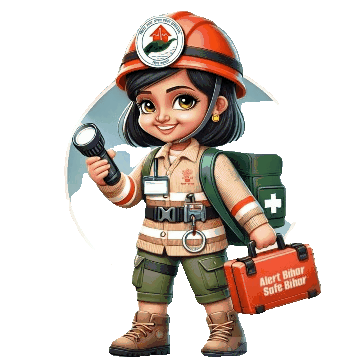DO’S AND DON’TS
Do’s:-
Before the Incidence:
- Construct /Identify basements in your residence where the whole family can stay for few days. In case no basement is available, plan to stay in a deep trench.
- Store food items, water and other items like baby food, etc., for emergency use as an accident in a nuclear facility having offsite consequences or explosion of a nuclear device can cause nuclear fallout. This fallout when settles on the ground will contaminate grass, soil, food, water, etc. Keep a stock of essential medicines also.
- Store in adequate number of candles and battery lights.
- Keep battery operated miniature transistor /TV sets in the shelter.
- Paste black paper on window/door glass panels. This has a dual purpose. Because of this you will not see the fireball that appears immediately following a nuclear blast. Directly looking at the fireball may make you temporarily or permanently blind. Also because of the blast, windows and door glasses will shatter upto a distance of few Kilometers. Pasting of paper will prevent glass splinters from spreading, and minimize chances of serious injury.
- Familiarize with instructions/ operational procedures being broadcast/telecast by the designated authorities.
- Familiarize with community shelters in your locality.
- Remove stocks of flammable items, if any.
- Keep a list of the items ready, which are to be taken when asked to evacuate. This may include identity card, cash, valuables, important documents, medicines, baby food,etc.
During the incidence:
- Stay calm.
- Drop to ground immediately, if in an open area, and remain in lying position.
- Position yourself in a deep trench or an underground shelter to save you from blast, heat and radiation.
- Protect eyes with palms and ears by fingers or thumbs to prevent ear drum rupture.
- Protect your body parts from thermal burns, radiation burns and direct contamination by covering with cloth.
- Remain indoors to save yourself from radiation and plume. Building will act as shield.
- Burn, injuries, dazzling of vision and confusion/chaos are expected.
- Cover your mouth and nose with a wet piece of cloth. Still better, put a face mask. It will prevent radioactive dust being inhaled.
- Put a lid/cover on all food items and water containers.
- Drive out of the way of any windows or doors to avoid injuries due to glass pane splinters.
- Switch on radio/TV and and follow official instructions, if any.
After the incidence:
- Stay calm.
- Stay down under cover until debris stop falling. Be vigilant about weak structures and tree felling.
- Look for basement area or take shelter in a room in your house, which has the least windows/doors.
- Burn, injuries, dazzle and concern for overexposure may combine to create panic.
- Dazzle is temporary and vision should return in few seconds.
- Close the doors and windows to save from fallout radiation.
- Try to cover the openings of shelters to prevent the entry of fallout particles.
- Keep heating or cooling system of the automobile off, if in vehicle;
- Get down on detection of flash, and try to reach a shelter, as blast wind will generally end in 1–2 minutes.
- Cover your mouth and nose with a wet piece of cloth. Still better, if you can put a face mask. It will prevent radioactive dust from being inhaled.
- Take potassium iodide or potassium iodide tablets, if radioactive isotopes of iodine are present, and if advised by authorities.
- Take bath and change clothes to decontaminate yourself.
- Keep in mind, as a thumb rule, if blast wave does not arrive within few seconds of the flash, you were far enough from the Ground Zero and the initial radiation exposure may not exceed the threshold of the deterministic effect (around 100-150 rads).
- Bear in mind that on surviving the blast, the chances of being exposed to lethal dose of radiation is relatively less unless one is located in an early fallout area.
- Expect some initial disorientation as the blast wave may blow down and carry away many prominent and familiar landmarks from your vicinity.
- Put off fires before they spread.
- Listen to T.V/ Radio for information updates.
- Keep Air-conditioners/ Coolers/Fans switched off.
- Follow simple decontamination procedure like removal of clothing worn outdoors and having a bath before entering safe areas, if coming from contaminated area.
- If advised, evacuate the area or move to a temporary shelter.
Don’ts
- Do not panic.
- Do not believe in rumours and don’t spread rumours.
- Do not look at the fire ball when explosion takes place. It may blind you or affect your vision.
- Do not consume uncovered food/drinks/water/beverages, etc.
- Do not move out of shelters /basements unless instructed by the authorities.
- Do not deliberately stir up dust or brush against things in the fallout areas.
- Do not smoke and avoid eating or drinking in the contaminated area.
- Do not kneel, lie or sit on the ground.
- Do not walk barefoot or in open slippers if in fallout area.
- Do not permit contaminated persons in basements/shelters unless decontaminated.
- Do not enter fallout areas, if evacuated.
- Do not disobey instructions of the District or Civil defence authorities, who will be doing their best to ensure your safety and also that of your family and community as a whole, besides ensuring safety of the property, infrastructure and environment.




 Back
Back
